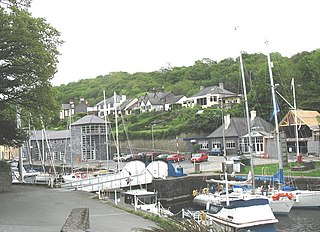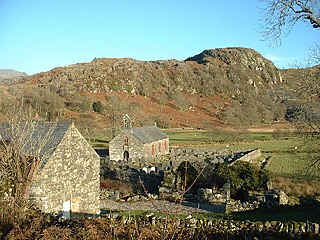
Tywyn, formerly spelled Towyn, is a town, community, and seaside resort on the Cardigan Bay coast of southern Gwynedd, Wales. It was previously in the historic county of Merionethshire. It is famous as the location of the Cadfan Stone, a stone cross with the earliest known example of written Welsh, and the home of the Talyllyn Railway.

Bala is a town and community in Gwynedd, Wales. Formerly an urban district, Bala lies in the historic county of Merionethshire, at the north end of Bala Lake. According to the 2021 census, Bala had a population of 1,999 and 72.5 per cent of the population could speak Welsh.

Cadair Idris or Cader Idris is a mountain in the Meirionnydd area of Gwynedd, Wales. It lies at the southern end of the Snowdonia National Park near the town of Dolgellau. The peak, which is one of the most popular in Wales for walkers and hikers, is composed largely of Ordovician igneous rocks, with classic glacial erosion features such as cwms, moraines, striated rocks, and roches moutonnées.

Y Felinheli, formerly known in English as Port Dinorwic, is a village and community beside the Menai Strait between Bangor and Caernarfon in Gwynedd, northwest Wales.

Ann Griffiths was a Welsh poet and writer of Methodist Christian hymns in the Welsh language. Her poetry reflects her fervent Christian faith and thorough scriptural knowledge.

Abergynolwyn is a village in southern Gwynedd, Wales, located at the confluence of the Nant Gwernol and the Afon Dysynni. The population of the community which is named after the village of Llanfihangel-y-Pennant was 339 at the 2011 census.

Llanuwchllyn is a village and community in Gwynedd, Wales, near the southern end of Bala Lake. It is one of the most sparsely populated communities in Wales.

The story of Mary Jones and her Bible inspired the founding of the British and Foreign Bible Society. Mary Jones was a Welsh girl who, at the age of fifteen, walked twenty-six miles barefoot across the countryside to buy a copy of the Welsh Bible from Thomas Charles because she did not have one. Thomas Charles then used her story in proposing to the Religious Tract Society that it set up a new organisation to supply Wales with Bibles.

Religion in Wales has become increasingly diverse over the years. Christianity was the religion of virtually all of the Welsh population until the late 20th century, but it rapidly declined throughout the early 21st century. Today, a plurality (46.5%) of people in Wales follow no religion at all.

Llanfihangel-y-Pennant is a small village in Gwynedd, Wales. It is in the community of Dolbenmaen in Snowdonia.
Llanfihangel can refer to the following places in Wales:

Llanrug is a medium-sized village and community in Gwynedd, north-west Wales. It lies about 4 miles (6.4 km) to the east of Caernarfon, 7 miles (11 km) south of Bangor and 3 miles (4.8 km) northwest of Llanberis. It is the largest populated village in the Arfon area of Gwynedd, Wales. The old name of the village was Llanfihangel-yn-y-grug, derived from Eglwys Sant Mihangel, which is situated about half a mile west of the village.
Llan and its variants are a common element of Celtic placenames in the British Isles and Brittany, especially of Welsh toponymy. In Welsh the name of a local saint or a geomorphological description follows the Llan morpheme to form a single word: for example Llanfair is the parish or settlement around the church of St. Mair. Goidelic toponyms end in -lann.

Bryncrug, sometimes spelt Bryn-crug, is a village and community in Gwynedd, Wales. Afon Fathew flows through the village and into the River Dysynni. The village is situated to the north east of the town of Tywyn, at the junction of the A493 and B4405 roads. Although the village is usually spelt Bryncrug in English, the community name uses the Welsh language version, Bryn-crug. The population of the community taken at the 2011 census was 622.

Buan is a community in the Welsh county of Gwynedd, located on the Llŷn Peninsula. It includes the villages of Boduan and Rhydyclafdy, and has a population of 469, increasing to 484 at the 2011 Census. Other settlements include Ceidio, Llandudwen and Llanfihangel Bachellaeth.

Dolbenmaen is a village and community in the Welsh county of Gwynedd, located in Eifionydd, of which it was the administrative centre until 1239. The community includes the villages of Bryncir, Cenin, Garndolbenmaen, Golan, Llanfihangel-y-Pennant, Penmorfa, Pentrefelin, Wern, Glan-dwyfach, and the hamlet of Prenteg. It has a population of 1,300, increasing slightly to 1,343 at the 2011 Census. The summit of Moel Hebog is shared between Beddgelert and Dolbenmaen. It is a sparsely populated area and covers nearly 100 square kilometres.

Tal-y-llyn, or Talyllyn, is a small hamlet and former parish in the community of Llanfihangel-y-Pennant in Gwynedd, Wales, situated at the end of Tal-y-llyn Lake close to the village of Abergynolwyn. The parish covered an area of 36,000 acres (15,000 ha). The River Dysynni flows out of the lake at this point, flowing down to enter Cardigan Bay north of Tywyn. Another lake known as Llyn y Tri Greyenyn or Llyn Bach was formerly located close to the border with the parish of Dolgellau.

Llanycil is a community in the county of Gwynedd, Wales, near Bala; it is 99.9 miles (160.7 km) from Cardiff and 176.2 miles (283.6 km) from London. In 2011 the population of Llanycil was 416, with 80.4% able to speak Welsh. The community includes the small settlements of Parc, Rhyd-uchaf and Llidiardau.

Mary Jones Pilgrim Centre (Welsh: Byd Mary Jones) is a small heritage centre located in Llanycil near Bala, Gwynedd, Wales. Situated on the north shore of Bala Lake, it provides information on Mary Jones, a fifteen-year-old girl from Llanfihangel-y-Pennant. After she had saved her money for six years, in 1800 Jones walked 26 miles to buy a copy of a Welsh-language Bible, which she thought would be available in Bala, only to find that they were sold out. The Reverend Thomas Charles was reputed to have given her his own spare copy.




















